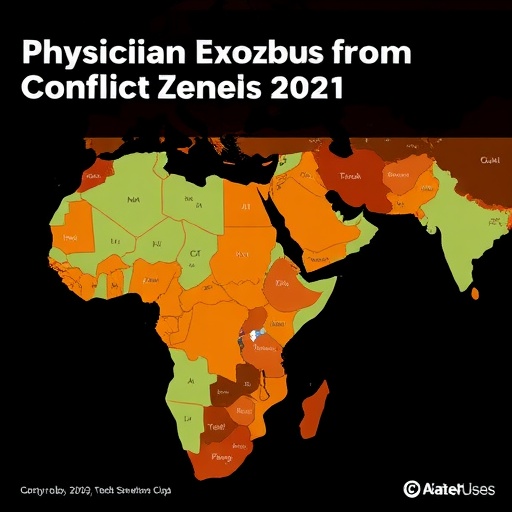The migration of healthcare professionals, particularly physicians, from conflict-affected countries has emerged as a pressing topic, capturing the attention of policymakers and health advocates alike. In the paper titled “Trends in Physician Emigration from Conflict-Affected Countries, 2006-2021,” the authors, Ramesh et al., meticulously analyze the patterns and implications of this phenomenon over a 15-year span. The insights provided in their research illuminate not only the challenges faced by these countries but also the global repercussions of a decreasing healthcare workforce in regions that are desperately in need of medical professionals.
Physician emigration has been a critical issue in the landscape of global health, with numerous specialists feeling compelled to leave their home countries amidst instability, violence, and economic hardship. The authors shed light on the multifaceted factors that drive these professionals to seek opportunities in more stable environments. Key among these factors are the deteriorating health infrastructure and the escalating safety concerns faced in conflict zones. As a result, a significant brain drain occurs, undermining the healthcare systems in the very nations that require their expertise the most.
The authors conducted a comprehensive review of existing literature and data sources, highlighting the significant regional disparities in physician emigration rates. Health systems in countries experiencing prolonged conflicts, such as Syria, Afghanistan, and Yemen, are particularly affected by workforce shortages. The findings suggest that these regions not only lose their skilled workforce but also struggle to attract new talent due to the adverse conditions that continue to persist.
The data presented in the study reveals a stark reality: as of 2021, the physician-to-population ratio in many conflict-affected countries is alarmingly low, leading to overwhelming burdens on the remaining healthcare providers. This shortage exacerbates health disparities and hinders access to care for millions of individuals, particularly vulnerable populations who depend heavily on local healthcare services. The resulting imbalance raises ethical questions about equity in health care and the global responsibility of wealthier nations to address these disparities.
Furthermore, the study explores the routes taken by emigrating physicians and the destinations they choose. Many opt for countries with well-established economies and stable political climates, such as the United States, Canada, and various European nations. However, the integration process often poses its own set of challenges, including the necessity of additional certifications and navigating the complexities of new healthcare systems. These hurdles can be discouraging, leading some physicians to abandon their aspirations of practicing medicine altogether.
The emotional toll of leaving one’s country cannot be understated; many physicians carry the weight of guilt and helplessness as they depart from communities in crisis. The study highlights the psychological impact of relocation on these professionals who often wish to contribute meaningfully to their home countries but find that circumstances have rendered such contributions untenable. The commitment to their fellow citizens often clashes with the instinct for self-preservation and professional survival.
Importantly, the authors also discuss the broader implications of physician emigration beyond individual experiences. They highlight how the departure of health professionals contributes to a cycle of deteriorating health services, which in turn can lead to increased mortality rates and a higher burden of disease in countries already struggling with conflict. The systemic challenges of rebuilding healthcare infrastructure in the aftermath of conflict are further complicated by the knowledge that the very professionals needed to enact change are increasingly lost to foreign systems.
To address the burgeoning emigration trends, Ramesh et al. call for international collaboration to develop strategies that promote physician retention in conflict-affected regions. This could involve enhancing working conditions, offering competitive salaries, and providing additional training and resources. Engaging diaspora communities in health system rebuilding efforts may also present a viable solution, allowing those who have emigrated to contribute their expertise remotely or during periodic returns to their home countries.
The authors emphasize the importance of understanding the narratives behind physician migration and the necessity of creating supportive environments that allow health professionals to thrive. By addressing the systemic barriers that contribute to emigration, stakeholders can work towards stabilizing healthcare in conflict-affected areas and ultimately improve health outcomes for millions.
Moreover, lessons learned from countries that have successfully implemented retention strategies could serve as valuable models for others facing similar challenges. Research into best practices in physician employment, training, and support can be foundational in facilitating the necessary changes required to maintain and nurture local talent. The authors advocate for a multi-faceted approach involving governments, NGOs, and healthcare organizations working in concert to address the complex issues of physician emigration.
In conclusion, the study by Ramesh et al. provides a critical perspective on the trends of physician emigration from conflict-affected countries and their implications for global health. By identifying the root causes and potential solutions, the authors contribute to an ongoing discourse on how to effectively address this pressing issue. As the world continues to grapple with the consequences of conflict and instability, understanding and mitigating the factors driving physician migration will be essential in fostering resilient healthcare systems capable of serving vulnerable populations.
Ultimately, the research highlights the necessity for solidarity among nations and organizations to prioritize the health of individuals in conflict-affected areas. This collaborative spirit is essential for developing sustainable solutions that ensure access to quality care and support for health professionals willing to serve their communities.
Subject of Research: Trends in physician emigration from conflict-affected countries.
Article Title: Trends in Physician Emigration from Conflict-Affected Countries, 2006-2021.
Article References:
Ramesh, T., Wozniak, G.D., Horvitz-Lennon, M. et al. Trends in Physician Emigration from Conflict-Affected Countries, 2006-2021.
J GEN INTERN MED (2025). https://doi.org/10.1007/s11606-025-09791-1
Image Credits: AI Generated
DOI: 10.1007/s11606-025-09791-1
Keywords: Physician emigration, conflict-affected countries, healthcare workforce, global health, brain drain, health disparities.




